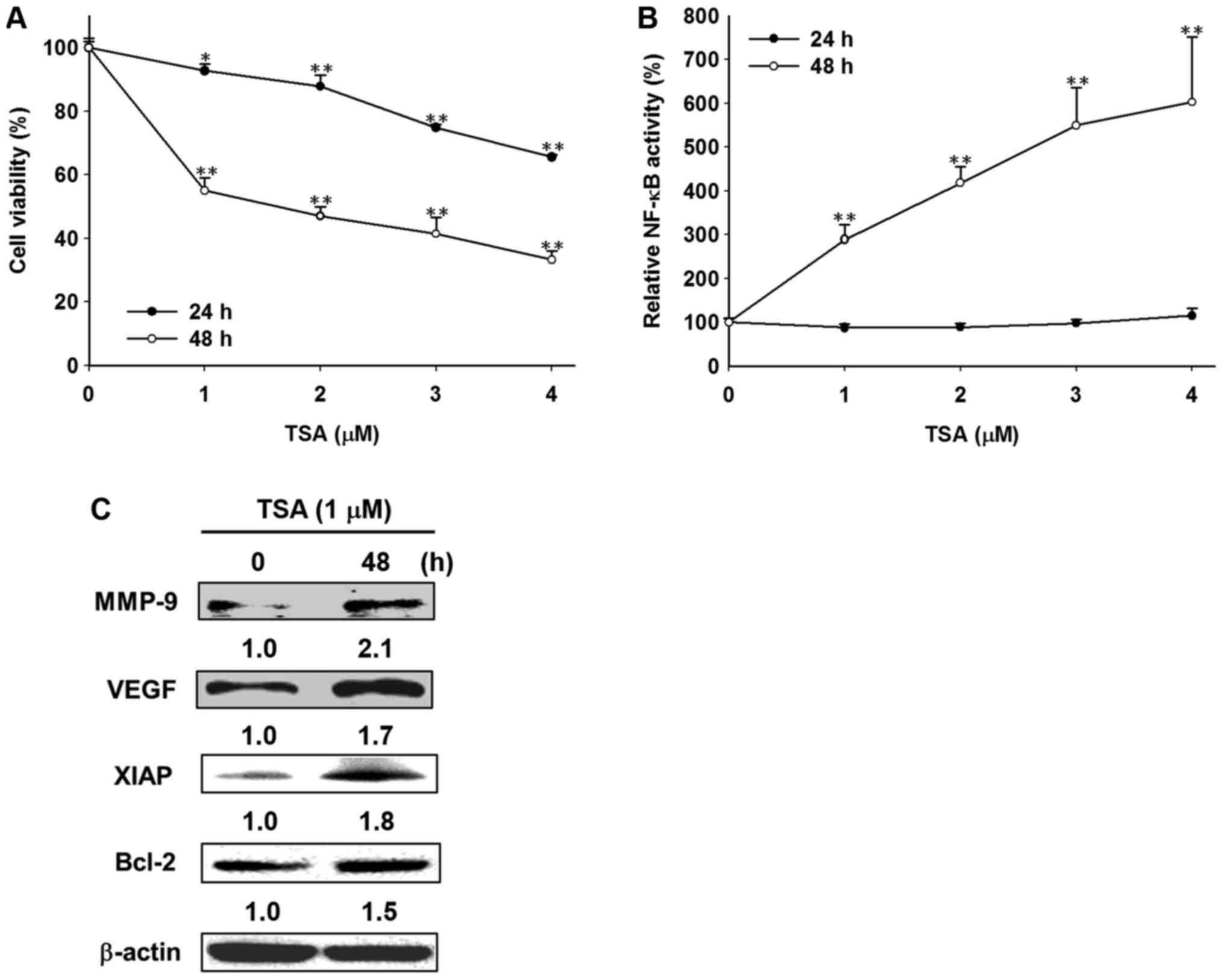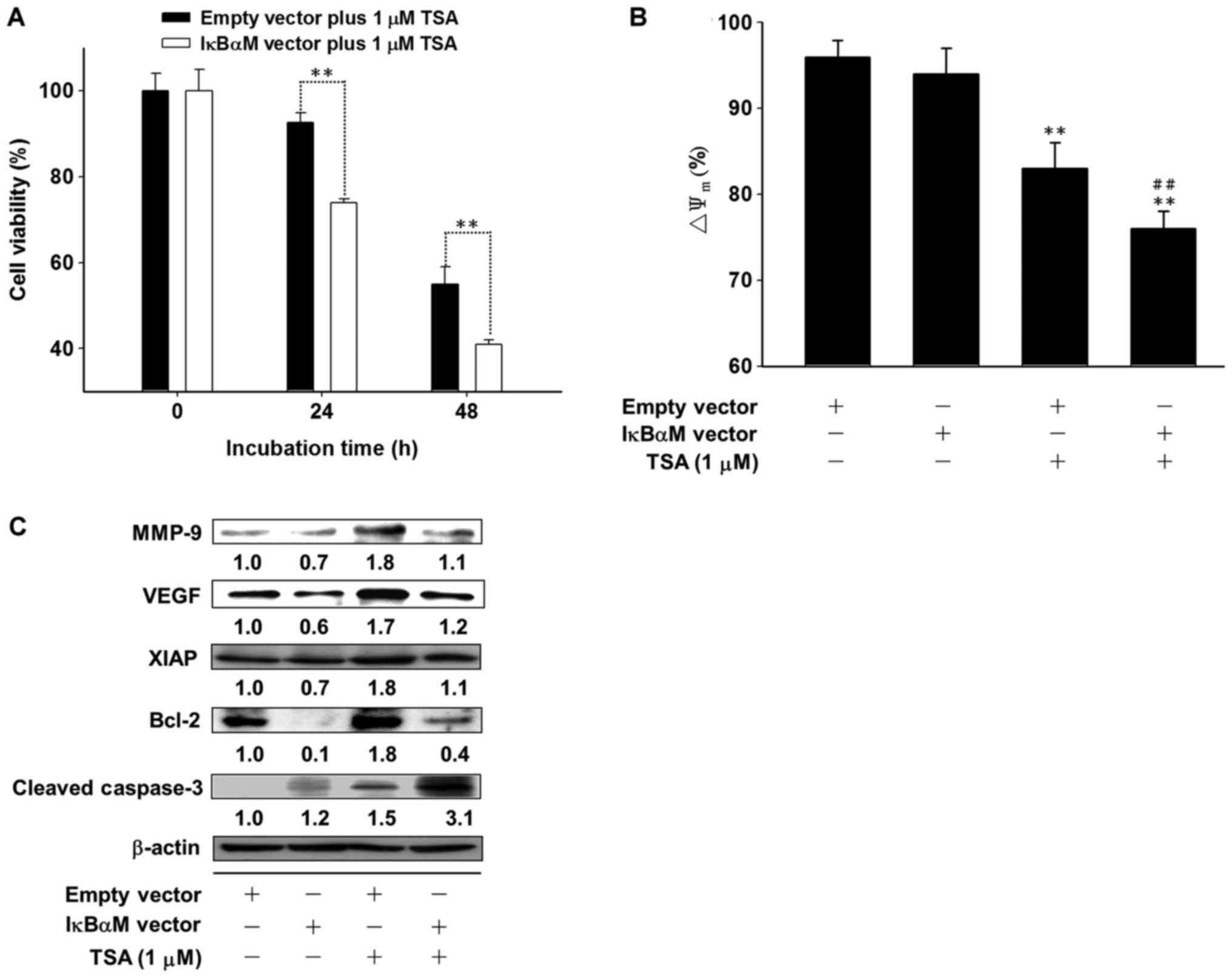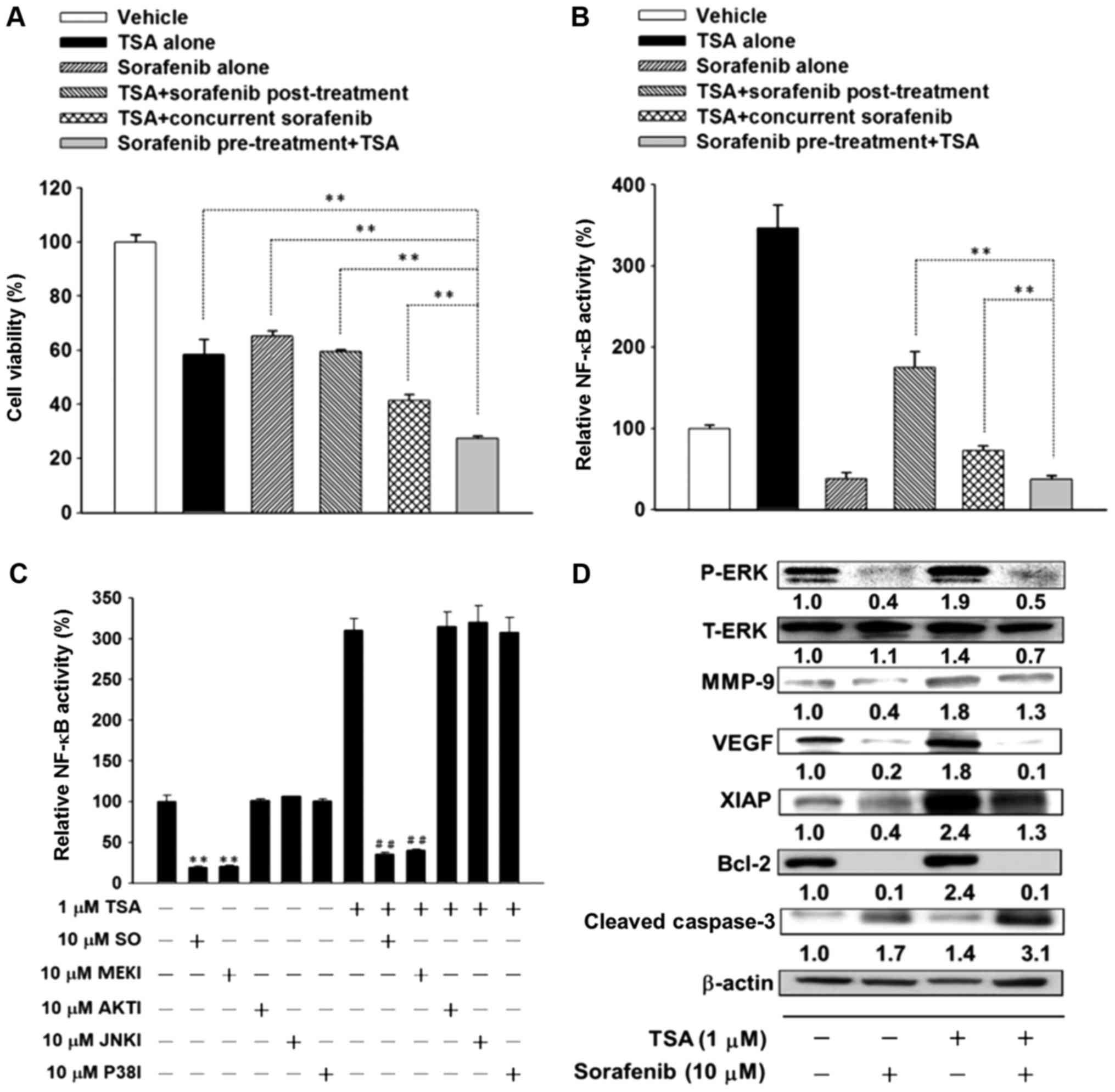|
1
|
Pan LN, Lu J and Huang B: HDAC inhibitors:
A potential new category of anti-tumor agents. Cell Mol Immunol.
4:337–343. 2007.PubMed/NCBI
|
|
2
|
Mund C and Lyko F: Epigenetic cancer
therapy: Proof of concept and remaining challenges. Bioessays.
32:949–957. 2010. View Article : Google Scholar : PubMed/NCBI
|
|
3
|
Rosato RR, Almenara JA and Grant S: The
histone deacetylase inhibitor MS-275 promotes differentiation or
apoptosis in human leukemia cells through a process regulated by
generation of reactive oxygen species and induction of
p21CIP1/WAF1. Cancer Res. 63:3637–3645. 2003.PubMed/NCBI
|
|
4
|
Baradari V, Höpfner M, Huether A, Schuppan
D and Scherubl H: Histone deacetylase inhibitor MS-275 alone or
combined with bortezomib or sorafenib exhibits strong
antiproliferative action in human cholangiocarcinoma cells. World J
Gastroenterol. 13:4458–4466. 2007. View Article : Google Scholar : PubMed/NCBI
|
|
5
|
Ngamphaiboon N, Dy GK, Ma WW, Zhao Y,
Reungwetwattana T, DePaolo D, Ding Y, Brady W, Fetterly G and Adjei
AA: A phase I study of the histone deacetylase (HDAC) inhibitor
entinostat, in combination with sorafenib in patients with advanced
solid tumors. Invest New Drugs. 33:225–232. 2015. View Article : Google Scholar : PubMed/NCBI
|
|
6
|
Yuan H, Li AJ, Ma SL, Cui LJ, Wu B, Yin L
and Wu MC: Inhibition of autophagy significantly enhances
combination therapy with sorafenib and HDAC inhibitors
(vorinostatin) for human hepatoma cells. World J Gastroenterol.
20:4953–4962. 2014. View Article : Google Scholar : PubMed/NCBI
|
|
7
|
Huang HL, Lee HY, Tsai AC, Peng CY, Lai
MJ, Wang JC, Pan SL, Teng CM and Liou JP: Anticancer activity of
MPT0E028, a novel potent histone deacetylase inhibitor, in human
colorectal cancer HCT116 cells in vitro and in vivo. PLoS One.
7:e436452012. View Article : Google Scholar : PubMed/NCBI
|
|
8
|
Chen CH, Chen MC, Wang JC, Tsai AC, Chen
CS, Liou JP, Pan SL and Teng CM: Synergistic interaction between
the HDAC inhibitor, MPT0E028 and sorafenib in liver cancer cells in
vitro and in vivo. Clin Cancer Res. 20:1274–1287. 2014. View Article : Google Scholar : PubMed/NCBI
|
|
9
|
Yao J, Duan L, Fan M and Wu X: NF-kappaB
signaling pathway is involved in growth inhibition, G2/M arrest and
apoptosis induced by trichostatin A in human tongue carcinoma
cells. Pharmaco Res. 54:406–413. 2006.
|
|
10
|
Zhang G, Park MA, Mitchell C, Hamed H,
Rahmani M, Martin AP, Curiel DT, Yacoub A, Graf M, Lee R, et al:
Vorinostat and sorafenib synergistically kill tumor cells via FLIP
suppression and CD95 activation. Clin Cancer Res. 14:5385–5399.
2008. View Article : Google Scholar : PubMed/NCBI
|
|
11
|
Duvic M and Vu J: Update on the treatment
of cutaneous T-cell lymphoma (CTCL): Focus on vorinostat. Biol
Targets Ther. 1:377–392. 2007.
|
|
12
|
Coradini D and Speranza A: Histone
deacetylase inhibitors for treatment of hepatocellular carcinoma.
Acta pharmacol Sin. 26:1025–1033. 2005. View Article : Google Scholar : PubMed/NCBI
|
|
13
|
Yan G, Graham K and Lanza-Jacoby S:
Curcumin enhances the anticancer effects of trichostatin a in
breast cancer cells. Mol Carcinogen. 52:404–411. 2013. View Article : Google Scholar
|
|
14
|
Yao J, Qian CJ, Ye B, Zhang X and Liang Y:
ERK inhibition enhances TSA-induced gastric cancer cell apoptosis
via NF-κB-dependent and Notch-independent mechanism. Life Sci.
91:186–193. 2012. View Article : Google Scholar : PubMed/NCBI
|
|
15
|
Tai DI, Tsai SL, Chang YH, Huang SN, Chen
TC, Chang KS and Liaw YF: Constitutive activation of nuclear factor
kappaB in hepatocellular carcinoma. Cancer. 89:2274–2281. 2000.
View Article : Google Scholar : PubMed/NCBI
|
|
16
|
Li W, Tan D, Zenali MJ and Brown RE:
Constitutive activation of nuclear factor-kappa B (NF-κB) signaling
pathway in fibrolamellar hepatocellular carcinoma. Int J Clin Exp
Patho. 3:238–243. 2010.
|
|
17
|
Wang WH, Chiang IT, Liu YC, Hsu FT, Chen
HW, Chen CL, Lee YJ, Lin WJ and Hwang JJ: Simultaneous imaging of
temporal changes of NF-κB activity and viable tumor cells in
Huh7/NF-kappaB-tk-luc2/rfp tumor-bearing mice. In Vivo. 27:339–350.
2013.PubMed/NCBI
|
|
18
|
Pan CC, Kavanagh BD, Dawson LA, LI XA, Das
SK, Miften M and Tan RK: Radiation-associated liver injury. Int J
Radiat Oncol. 76 Suppl:S94–S100. 2010. View Article : Google Scholar
|
|
19
|
Liu YC, Chiang IT, Hsu FT and Hwang JJ:
Using NF-κB as a molecular target for theranostics in radiation
oncology research. Expert Rev Mol Diagn. 12:139–146. 2012.
View Article : Google Scholar : PubMed/NCBI
|
|
20
|
Dai Y, Guzman ML, Chen S, Wang L, Yeung
SK, Pei XY, Dent P, Jordan CT and Grant S: The NF (Nuclear
factor)-kappaB inhibitor parthenolide interacts with histone
deacetylase inhibitors to induce MKK7/JNK1-dependent apoptosis in
human acute myeloid leukaemia cells. Brit J Haematol. 151:70–83.
2010. View Article : Google Scholar
|
|
21
|
Hsu FT, Liu YC, Chiang IT, Liu RS, Wang
HE, Lin WJ and Hwang JJ: Sorafenib increases efficacy of vorinostat
against human hepatocellular carcinoma through transduction
inhibition of vorinostat-induced ERK/NF-κB signaling. Int J Oncol.
45:177–188. 2014. View Article : Google Scholar : PubMed/NCBI
|
|
22
|
Chiang IT, Liu YC, Wang WH, Hsu FT, Chen
HW, Lin WJ, Chang WY and Hwang JJ: Sorafenib inhibits TPA-induced
MMP-9 and VEGF expression via suppression of ERK/NF-κB pathway in
hepatocellular carcinoma cells. In Vivo. 26:671–681.
2012.PubMed/NCBI
|
|
23
|
Kuo YC, Lin WC, Chiang IT, Chang YF, Chen
CW, Su SH, Chen CL and Hwang JJ: Sorafenib sensitizes human
colorectal carcinoma to radiation via suppression of NF-κB
expression in vitro and in vivo. Biomed Pharmacother. 66:12–20.
2012. View Article : Google Scholar : PubMed/NCBI
|
|
24
|
Meidhof S, Brabletz S, Lehmann W, Preca
BT, Mock K, Ruh M, Schüler J, Berthold M, Weber A, Burk U, et al:
ZEB-1 associated drug resistance in cancer cells is reversed by
class I HDAC inhibitor mocetinostat. EMBO Mol Med. 7:831–847. 2015.
View Article : Google Scholar : PubMed/NCBI
|
|
25
|
Rundall BK, Denlinger CE and Jones DR:
Combined histone deacetylase and NF-kappaB inhibition sensitizes
non-small cell lung cancer to cell death. Surgery. 136:416–425.
2004. View Article : Google Scholar : PubMed/NCBI
|
|
26
|
Domingo-Domenech J, Pippa R, Tapia M,
Gascon P, Bachs O and Bosch M: Inactivation of NF-kappaB by
proteasome inhibition contributes to increased apoptosis induced by
histone deacetylase inhibitors in human breast cancer cells. Breast
Cancer Res Tr. 112:53–62. 2008. View Article : Google Scholar
|
|
27
|
Ly JD, Grubb DR and Lawen A: The
mitochondrial membrane potential (deltapsi(m)) in apoptosis; an
update. Apoptosis. 8:115–128. 2003. View Article : Google Scholar : PubMed/NCBI
|
|
28
|
Li Q, Hu Y, Xi M, He L, Zhao L and Liu M:
Sorafenib modulates the radiosensitivity of hepatocellular
carcinoma cells in vitro in a schedule-dependent manner. BMC
Cancer. 12:4852012. View Article : Google Scholar : PubMed/NCBI
|
|
29
|
Yu W, Gu K, Yu Z, Yuan D, He M, Ma N, Lai
S, Zhao J, Ren Z, Zhang X, et al: Sorafenib potentiates irradiation
effect in hepatocellular carcinoma in vitro and in vivo. Cancer
Lett. 329:109–117. 2013. View Article : Google Scholar : PubMed/NCBI
|
|
30
|
Chen J CH, Chuang HY, Hsu FT, Chen YC,
Chien YC and Hwang JJ: Sorafenib pretreatment enhances radiotherapy
through targeting MEK/ERK/NF-κB pathway in human hepatocellular
carcinoma-bearing mouse model. Oncotarget. 2016.(in press).
|
|
31
|
Komarova NL, Katouli AA and Wodarz D:
Combination of two but not three current targeted drugs can improve
therapy of chronic myeloid leukemia. PLoS One. 4:e44232019.
View Article : Google Scholar
|












